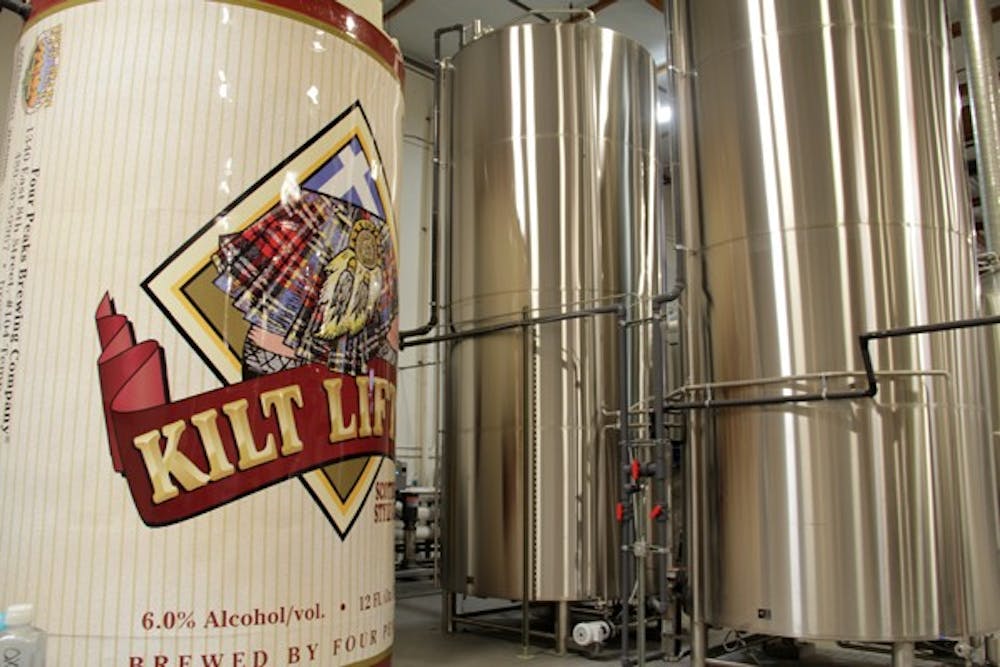 At its newest Tempe location near Broadway Road and Roosevelt Street, Four Peaks Brewery’s reverse osmosis system for water is housed in the giant version of their Kilter Lifter can. (Photo by Shawn Raymundo)
At its newest Tempe location near Broadway Road and Roosevelt Street, Four Peaks Brewery’s reverse osmosis system for water is housed in the giant version of their Kilter Lifter can. (Photo by Shawn Raymundo)An ASU startup company is partnering with a popular Tempe bar to remove pollutants in the brewery's wastewater.
The city of Tempe charges Four Peaks Brewing Company for the pollutants in its water, because the city must later pay to remove the pollutants itself, said Mark Sholin, the founder and president of Arbsource, a company that is commercializing technology to remove pollutants from industrial wastewater.
?“We’re actually gearing up for our first field-test pilot at Four Peaks Brewing Company,” he said.
?Sholin said Four Peaks recently opened up a new brewery on Broadway Road and Roosevelt Street that will be double the size of the company’s existing brewery and is in need of an on-site wastewater treatment facility to lower its water bills.
?Sholin’s first encounter with this wastewater treatment technology came while working as a summer research assistant at ASU’s Biodesign Institute during his undergraduate studies at UA.
Heenrolled in a Ph.D. program in biological design at ASU during the fall 2010 semester but put this on hold a year later to focus on Arbsource.
Arbsource’s technology will remove pollutants from the wastewater, both cleaning the water and reducing utility costs.
“That’s what Arbsource is all about: to be a conduit for the fundamental research that’s already taking place and to get it out to the market,” Sholin said.
?Sholin said research on these wastewater treatment technologies has been taking place at ASU since 2006.
?ASU Venture Catalyst is a program aimed at supporting ASU students, staff and faculty with developing startup companies.
?Wiley Larsen, venture manager at Venture Catalyst, said that in addition to the nine startup companies that developed out of ASU research in 2012, there were 10 in 2011, and there are potentially between 13 and 16 new companies being developed before the end of fiscal year 2013.
?Venture Catalyst has a goal to produce approximately 20 startup companies per year, about as many as Stanford University and the Massachusetts Institute of Technology developin the same amount of time.
Larsen said he has seen many of ASU’s startup companies working with medical technologies and in the areas of sustainability, energy, material science and education technology.
?Material science technology includes work with solar panels and semi-conductors, he said.
?The biggest economic impact that these new startups have is producing more jobs, Larsen said.
?“We really view those (startups) as brand-new jobs," Larsen said. "Each one of those teams is creating a new job that never existed before, and so there’s definitely economic impact there.”
The Arizona Board of Regents listed Arbsource as one of 15 notable startup companies that grew last year out of Arizona’s public universities in its annual report on university research.
Among the other startup companies that came out of ASU last yearwere Moved by Reading LLC., a company that develops tools for English reading comprehension, and GreenCave Productions LLC., a company that is creating educational products for teaching math at the grade-school level.
These startup companies are important to the growth of Arizona’s economy, board spokeswoman Sarah Harper said.
?The regents’ research report summarizes the new startups that developed out of ASU research in 2012 as part of its comprehensive look at how the in-state universities are working toward goals set for them by the Board of Regents.
?The board developed a set of goals in 2010 for Arizona’s public universities to accomplish by the year 2020.
These included raising total research expenditures at the university level from $900 million in 2010 to $2 billion in 2020, according to a report published in 2010 by the board.
?“(The Board of Regents) established pretty aggressive goals to meet by 2020. That is part of our role as a partner in Arizona’s economy,” Harper said.
She said the board wants its plan to prepare Arizona for the workforce of 2020, in terms of numbers of individuals with bachelor’s and advanced degrees.
Reach the reporter at svhabib@asu.edu or follow her on Twitter @discoanddessert




